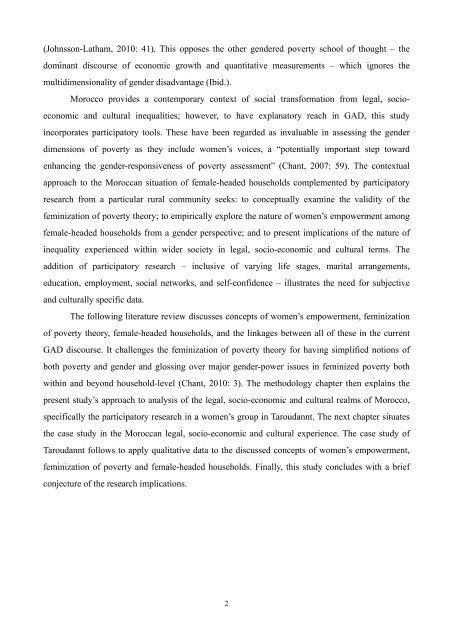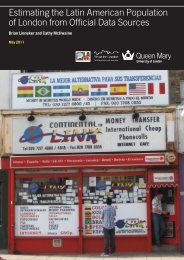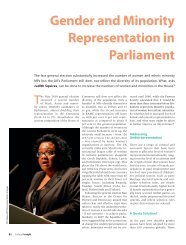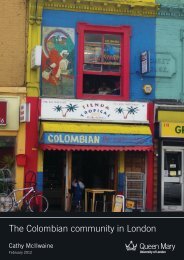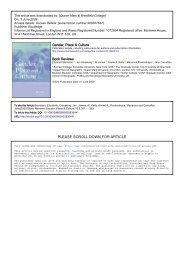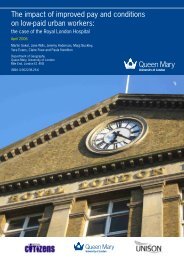Women's Empowerment and the Feminization of Poverty among
Women's Empowerment and the Feminization of Poverty among
Women's Empowerment and the Feminization of Poverty among
- No tags were found...
Create successful ePaper yourself
Turn your PDF publications into a flip-book with our unique Google optimized e-Paper software.
(Johnsson-Latham, 2010: 41). This opposes <strong>the</strong> o<strong>the</strong>r gendered poverty school <strong>of</strong> thought – <strong>the</strong>dominant discourse <strong>of</strong> economic growth <strong>and</strong> quantitative measurements – which ignores <strong>the</strong>multidimensionality <strong>of</strong> gender disadvantage (Ibid.).Morocco provides a contemporary context <strong>of</strong> social transformation from legal, socioeconomic<strong>and</strong> cultural inequalities; however, to have explanatory reach in GAD, this studyincorporates participatory tools. These have been regarded as invaluable in assessing <strong>the</strong> genderdimensions <strong>of</strong> poverty as <strong>the</strong>y include women’s voices, a “potentially important step towardenhancing <strong>the</strong> gender-responsiveness <strong>of</strong> poverty assessment” (Chant, 2007: 59). The contextualapproach to <strong>the</strong> Moroccan situation <strong>of</strong> female-headed households complemented by participatoryresearch from a particular rural community seeks: to conceptually examine <strong>the</strong> validity <strong>of</strong> <strong>the</strong>feminization <strong>of</strong> poverty <strong>the</strong>ory; to empirically explore <strong>the</strong> nature <strong>of</strong> women’s empowerment <strong>among</strong>female-headed households from a gender perspective; <strong>and</strong> to present implications <strong>of</strong> <strong>the</strong> nature <strong>of</strong>inequality experienced within wider society in legal, socio-economic <strong>and</strong> cultural terms. Theaddition <strong>of</strong> participatory research – inclusive <strong>of</strong> varying life stages, marital arrangements,education, employment, social networks, <strong>and</strong> self-confidence – illustrates <strong>the</strong> need for subjective<strong>and</strong> culturally specific data.The following literature review discusses concepts <strong>of</strong> women’s empowerment, feminization<strong>of</strong> poverty <strong>the</strong>ory, female-headed households, <strong>and</strong> <strong>the</strong> linkages between all <strong>of</strong> <strong>the</strong>se in <strong>the</strong> currentGAD discourse. It challenges <strong>the</strong> feminization <strong>of</strong> poverty <strong>the</strong>ory for having simplified notions <strong>of</strong>both poverty <strong>and</strong> gender <strong>and</strong> glossing over major gender-power issues in feminized poverty bothwithin <strong>and</strong> beyond household-level (Chant, 2010: 3). The methodology chapter <strong>the</strong>n explains <strong>the</strong>present study’s approach to analysis <strong>of</strong> <strong>the</strong> legal, socio-economic <strong>and</strong> cultural realms <strong>of</strong> Morocco,specifically <strong>the</strong> participatory research in a women’s group in Taroudannt. The next chapter situates<strong>the</strong> case study in <strong>the</strong> Moroccan legal, socio-economic <strong>and</strong> cultural experience. The case study <strong>of</strong>Taroudannt follows to apply qualitative data to <strong>the</strong> discussed concepts <strong>of</strong> women’s empowerment,feminization <strong>of</strong> poverty <strong>and</strong> female-headed households. Finally, this study concludes with a briefconjecture <strong>of</strong> <strong>the</strong> research implications.2


